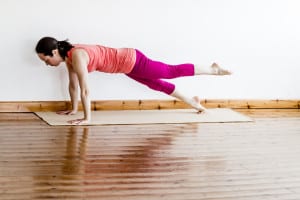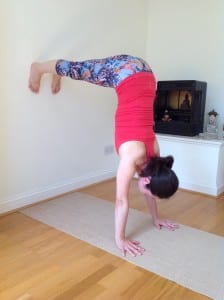It’s January and the shoots of spring flowers have already popped up in our garden.
My yoga practice feels a little like them. I feel a renewed energy at this time of year, bolstered by my resolve and conviction for the year ahead. I want to be active and step into new territory. Yet I also know that there is so much essential, quiet work going on under ground or ‘behind the scenes’ – what I call the ‘invisible’ work that holds everything else together and enables plans to fully come to fruition.
Winter yoga supports us on both these levels. It offers practices that keep us energised, strong and warm at a time when our immune system can be challenged, and those that support our clarity and a positive mind-set in the darker and colder days. It keeps our inner fire stoked.
In Ayurvedic terms, this approach also helps us to be or work optimally with the prevailing doshas (our mental/physical/emotional tendencies) of the season. In the case of winter, these are kapha and vata.
You can read more about the implications of vata in my autumn yoga post here.
Associated with water and earth elements, kapha governs the structure, tissues and fluids of the body. It protects us. Kapha types tend to be well built, with good stamina. An increase or excess of kapha in winter however, can lead to lethargy, fluid build-up/retention, congestion, sluggish digestion, increased discomfort in the cold or damp and resistance to change. Yes, we can be even more stubborn than usual….
With that in mind, here are 3 winter yoga practice tips to nurture those spring shoots:
1. Sustain your energy levels and support your immune system
In winter it’s important to keep modifying the speed and intensity of our asana (posture) practice as necessary. Some days we may feel like a strong, dynamic practice, others a more static, gentle or restorative one. Alternate when needed, without giving yourself a hard time about it. The variation keeps us mentally alert and our practice fresh, away from being stuck in our ways or drifting into ‘automatic pilot’ mode.
As ever, allow your practice to be guided by what your body and heart tell you.
In fact, it’s the quiet, ‘small’ practices which don’t look like anything special – a mindful, simple asana flow, breathing techniques, meditation, restorative poses, yoga nidra – that give us the most energy and bolster our immune system. Consistency, gradual progression and a lack of obsession or attachment to results are the key to keeping our ground fertile in winter, ready – if we wish – for bigger (and more visible) things later on. The process is what matters.
‘The practice of yoga will be firmly rooted when it is maintained consistently and with dedication over a long period’. Yoga Sutras, Patanjali
On the physical side, foundational, energising backbends and heart/chest/throat openers such as cobra, bridge and modified fish pose work well in winter.
We can do the groundwork for arm-balances and inversions by gradually building strength in our core (e.g. boat pose prep with a block between bent knees to full boat) and upper body (e.g. forearm plank, plank to one-legged or one-armed plank, half-handstand with feet against the wall).
One-legged plank Half-handstand with wall
For more subtle – and powerful – practices to support and balance this physical work try these energising, purifying and immune-boosting pranayama (breathing) techniques (with the guidance of a teacher if needed):
– surya bedhana (vitality stimulating/sun breath)
– kapalabhati (shining/frontal brain cleansing breath) or
– ujjayi (psychic/victorious breath)
In addition, jala neti (nasal cleansing with water) is a easy-to-do technique that will help with excess mucus, allergies and congestion.
For a grounding pranayama, see my recommendation of nadi sodhana (alternate nostril breathing) here.
If you do find yourself succumbing to a winter cold or flu, restorative yoga will aid your recovery and encourage your body’s self-healing. A side-lying resting pose or those in which the head and chest are higher than the hips will be most comfortable if you are feeling congested.
2. Instil a positive mindset with a simple daily habit
Dedication to just two minutes of this type of practice a day keeps stress at bay, our mind clear and our spirits lifted. Over time the cumulative effects are miraculous. This is time wisely spent. Here are three options:
– Take a couple of minutes for quiet sitting/meditation first thing in the morning/after the school run or at lunchtime. You can find audio guidance here.
– Enjoy a daily dose of nature and sunlight. This can be incorporated into your journey to work or a lunch break. A brisk (or slow if you prefer) walk will do. It also helps with Vitamin D and serotonin levels.
– Before you go to bed at night, or at a quiet point in the afternoon reflect on just one thing that has been positive that day. The simpler the better – seeing a friend or loved one, enjoying a good meal, walking in the park or completing a great piece of work. You will naturally feel gratitude for it. Know that there are always times such as these when things come easily to you, when any struggle or obstacles disappear. The more consistent our practice is, the more often we experience such ease in day-to-day life.
3. Stay true to your resolve
New Year’s resolutions so often fall by the wayside. This is usually because they don’t actually reflect what is important to us and stem from an imagined place of lack or self-criticism. Take heart in the fact that there is a more meaningful and sustainable way to fulfil your heart’s desire and dharma, your purpose in life.
Rather than focusing on ‘I want’ or ‘I will be’, listen to your inner sankalpa or resolve. An intention such as ‘I am peaceful’, ‘I am compassionate’, ‘I take care of myself’ or ‘I fulfil my life’s purpose’ is accessible to us on all levels while also being free of inner conflict and limiting habits. Set your intention from a place of quiet and see what really moves you. This will sustain you and all the actions you are here to take throughout the year and beyond. Regular yoga and meditation practice keeps us steady and motivated as we do this.
I hope these simple tips help to guide you easefully and contentedly through winter. Keep up the quiet, ‘invisible’ work. It’s what makes us flourish.

